The Silver Jubilee
Introduced in 1935, Clive and I described how this express evolved in the book but could only offer two illustrations. For a while it must have been the most photographed train in the world, and being so photogenic, here are more views and how the images were treated. There will be several parts, covering the various changes:
Phase 1 - 1935-36 Phase 2 - 1936-38 Phase 3 - 1938-39
New additions placed here temporarily.
One of Wethersett's masterpieces shows a scene on 25th May 1937 at Marshmoor as the Down "Silver Jubilee" approaches behind A4 No 2510 Quicksilver. This is in what I have called Phase 2 when details of the locos had been modified.
Passing in the opposite direction on the Up fast line is Ivatt C1 No 4449 with an Outer Suburban train. Leading is a 1935-built steel-panelled twin (BT-CL) with the composite behind the tender. This appears to be the 6pm from Baldock. Photo: ER Wethersett.
Click on the image for an enlargement
Phase 1 - 1935-36
Pre-service

An LNER official view of the new train being delivered by A4 No 2509 Silver Link. I have yet to establish the location except to say that it's on the four-track and the train is carrying ECS lights and may have been posed. So many steam-era pictures were adjusted and in this case the upper cab was burned in to conceal the driver leaning out of the cab. I have tried to correct the worst of this but the man remains an unidentifiable black shape. Photo: author's collection, LNER TS 29.
Click on the image for an enlargement
The demonstration run
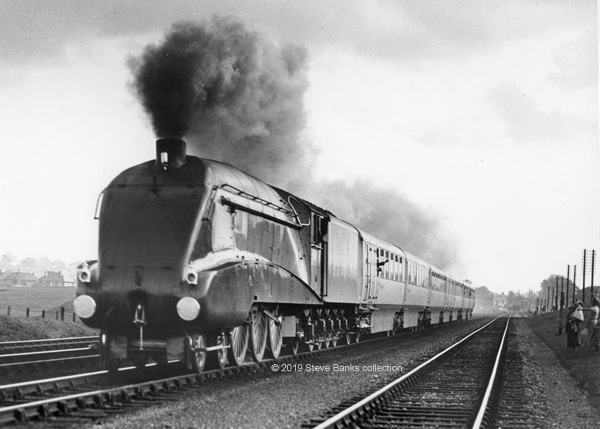
Revised caption
This picture was taken on Friday 27th September 1935 near Potters Bar and shows the public demonstration run containing invited guests and the press. It's sometimes called a "trial run" but it was hardly that but a skilful PR exercise.
The photographer was ER Wethersett and it rates as one of the finest of all from the steam era. We used this picture in the book and I show it again here so that it can be compared with the view that was released as a postcard by The Locomotive Publishing Co. Ltd., shown below. The lineside fencing in those days was perfunctory and many people climbed over to stand by the track to see the flyer race by, including mothers and children. The guard is returning the many waves. When I was relatively young myself I knew the photographer and regret never having been able to ask him about this picture; such is life. Photo: E.R. Wethersett.
Click on the image for an enlargement

The version produced as a postcard by LPC differed from ERW's in a couple of ways. All the people by the lineside were tactfully taken out. More interestingly, the heavy exhaust over the train was toned down, cleaned-up, you could say and it's certainly a more dramatic picture, especially with the caption underneath. The social side of the event may have been lost but, there we are, and both versions may be enjoyed today. Photo: LPC.
Click on the image for an enlargement
The service begins

I have come across this long-deleted Colour-Rail slide showing A4 No 2509 Silver Link on the "Silver Jubilee" at Darlington and a caption of "7-35", which cannot be right as the train didn't enter service until the last day of September 1935. The loco is in the original condition and an old Colour-Rail catalogue quotes the first week of service in October. It's attributed to Jack Crossley.
The slide is quite yellow and vignetted, which I have tried to repair, and shows the Up train in the morning at around 10.40am (it called at Darlington) with a faint gleam of autumnal sunlight on it. There are sharper views in b&w but this captures the essence of the new train in its north-eastern context. The buildings are smoke-laden, an ex-NER clerestory carriage can be seen alongside, possibly a departing secondary service, and an ex-NER signal gantry with slotted posts. I may be wrong but I think the whistle is being blown to herald its arrival and as many people know, the three-note chime once heard is unforgettable. Note by the way that this named express never carried a headboard on the loco: there was no need! Colour-Rail NE.99.
Click on the image for an enlargement
I've added part of the OS 25" map for 1939-47 although its tricky because the location falls on the border of two maps - that's the horizontal black line where for once I was unable to line the two up precisely - there are small differences between each map that cannot be reconciled. Source: National Library of Scotland.
If you'd like to see them yourself the links are here:
https://maps.nls.uk/view/120939177 https://maps.nls.uk/view/120939216

The train is almost dead centre on the map with a fragment of the signal box visible on the left (marked "S.B.") and the back of Adelaide Street on the right (they would have been railwaymen's cottages, hence the liberal advertising with enamelled signs on the railway side). The train is about to cross over from the Up fast line.to stop at the platform, indeed, the loco's leading wheels have just begun that move. There was no messing about at Darlington where the timetable allowed two minutes for passengers with reserved seats to climb aboard - those without reservations stood little chance of finding a vacant seat - and the train was off again, non-stop all the way to London.

The "Silver Jubilee" was a thing of beauty and artists strived to show it, as this oh-so-pretty view shows, apparently bought in Brighton and posted to an address in Bristol. Only a pity that the date isn't legible. The caption on the back only offers "on the East Coast Main Line" and though a photograph would have been used to work off, the location looks fictional, and the artist could only be bothered to paint one running line!
He got the original condition of the the loco Silver Link right, with recessed coupling on the front and no running number. The front's a bit exaggerated with the chimney a bit on the small side, and the articulated carriage bogies were beyond his ken, but, hey, it's still a rather nice painting which looks so sleek. Postcard by J.Salmon Ltd., Sevenoaks, author's collection.
Click on the image for an enlargement

The Up "Silver Jubilee" in July 1936 behind A4 No 2509 Silver Link was captured at Ganwick by H. Gordon Tidey and this is his signed print. It's a landscape style view that was rare at the time and the silver train not only contrasts with the British countryside but its relatively short length may just be detected. The photographer may have tried to show this deliberately for pictures taken here of the Flying Scotsman with 15 carriages show a train stretching far back along the curve in the distance! Photo: H. Gordon Tidey.
Click on the image for an enlargement
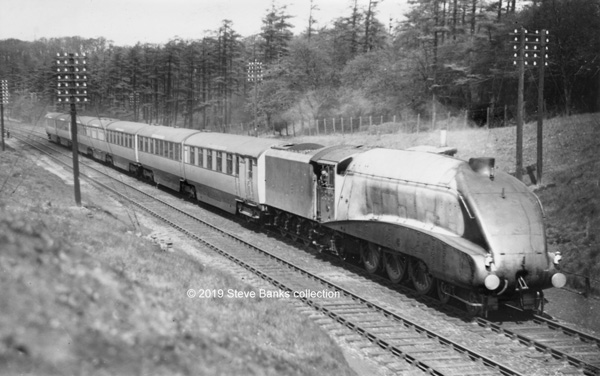
A relatively modern print on resin coated paper carries the file ref of "T8700" and the crop is more conventional, giving a modern telephoto lens feel to the picture. The letter "T" was used by Real Photographs to indicate an H. Gordon Tidey picture. Photo: Cliff Parsons collection.
Click on the image for an enlargement

The final view from this sequence is dated 1936 and shows the front coupling still in its pocket. In July of that year it was relocated further out and the straight handrail was curved down at the cab end. These changes form a second period (to follow). No 2509 Silver Link was captured racing through Welwyn Garden City with the regulator open prior to the final, six-mile ascent to Potters Bar and its ruling gradient of 1:200. The photographer seems to have struggled with the speed of the train!
This time I have made some adjustments, correcting the tilt and trying to show the exhaust. Photo: R.S. Carpenter collection, Neg. No 1277.
Click on the image for an enlargement
Phase 2 - 1936-38
It's unfortunate that most of the next series of pictures are not dated although they are known to have been taken between July 1936 and 1938. A visible change to the locos took place after a fatal accident when a man was crushed between one of the streamlined A4s when trying to couple up: the front coupling pocket was promptly filled in and longer buffers fitted. This took place in July 1936 (2509-11) and October 1936 (2512). Some other relatively small changes also took place and these are described in the captions.
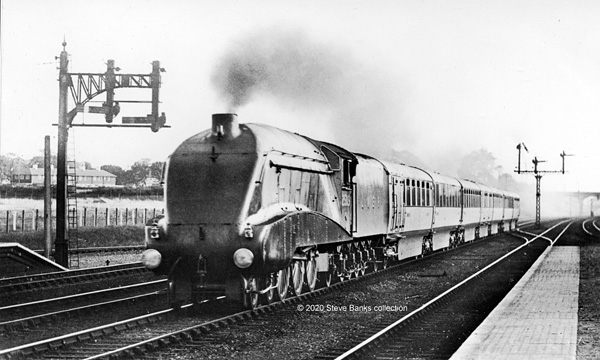
When No 2509 Silver Link entered service the handrail along the boiler was straight all the way to the cab and was not curved until a little after the coupling pocket was eliminated - this being the only picture I know of the intermediate condition. With the main line signals off the the Down "Silver Jubilee" still looks sparklingly clean as it sweeps through Welwyn Garden City station on the two-mile ascent at 1:200 between Hatfield and Digswell Viaduct. Photo: A sepia postcard by Dr. T.F. Budden, LPC.
Click on the image for an enlargement
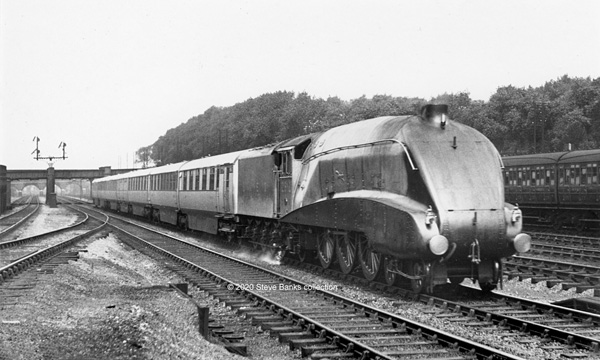
Showing the revised handrail at the cab end, No 2512 Silver Fox has the Up train near Greenwood. A number has yet to be painted on the front. Photo: Ken Nunn Collection, LCGB.
Click on the image for an enlargement

The fireman is clearly busy as No 2510 Quicksilver (now with a front end number in small letters) emerges from Hadley Wood Tunnel in the middle of the eight-mile ascent at 1:200 between Wood Green and Potters Bar. Photo: LPC.
Click on the image for an enlargement
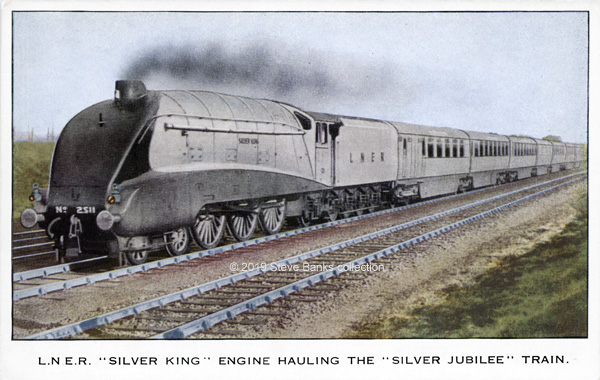
A Valentine's colour postcard showing the train at an unknown location with Gateshead's No 2511 Silver King in charge. Cards like this were often based on an actual photograph but I have yet to find it; there is a Potters Bar feel to the view.
The loco has gained a number on the front although the pale blue lamps with red spectacles are a bit of artistic licence. The carriages appear to be in the original condition with a silver roof. It seems that at some stage it was decided to paint the roofs white. This shows quite clearly on many of the photographs but confirmation from LNER records has yet to be found. Author's collection
Click on the image for an enlargement

No 2510 Quicksilver has the Up service and has just passed under the footbridge over the cutting which leads to Potters Bar Tunnel. The hard work is over and the last dozen miles are nearly all downhill. 4th August 1936. Photo: Ken Nunn Collection, LCGB.
Click on the image for an enlargement

My apologies for showing this picture again (previously used in "LNER Flyers from the Air" in Back Track) but it is rather good and shows No 2510 Quicksilver in summer 1936 with the Up train on Digswell Viaduct. LNER Press Section TS/43, Author's collection.
Click on the image for an enlargement

No 2510 Quicksilver again, this time near Potters Bar. The loco is spotless but the carriages are are in dire need of a wash! Photo: Author's collection.
Click on the image for an enlargement

A rare view of the A4 allocated to Gateshead, No. 2511 Silver King, deputising for a King's Cross loco on the Up train, passing Peterborough North. There's either a leak or the chime whistle is being blown. Photo: T.G. Hepburn, Rail Archive Stephenson.
Click on the image for an enlargement

No.2512 Silver Fox acquired larger letters for the front-end number in late summer 1937 and is seen laying smoke on the ascent near Potters Bar. Photo: Author's collection.
Click on the image for an enlargement

In another view from 1937, with twelve miles to go, No 2509 Silver Link is speeding down the 1:200 out of Potter's Bar Tunnel, also now carrying the larger letters on the nose. Photo: Author's collection.
Click on the image for an enlargement
Phase 3 - 1938-39
The final phase, when an extra carriage was added by converting the twin at the north end from BTK-TK into a triplet: BTK-TK-TK. Surprisingly few pictures were taken of the new 8-coach formation, here are three. Not all the pictures are dated but would have been either 1938 or 1939:
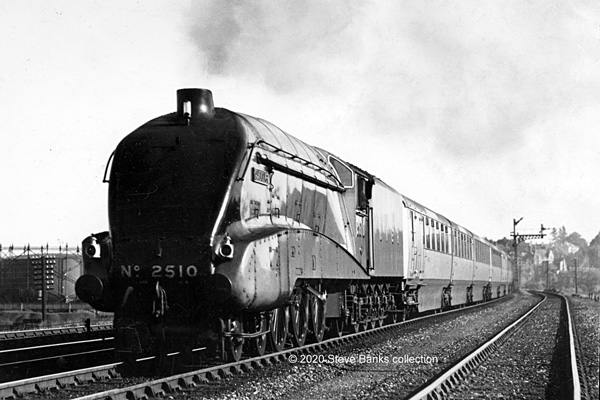
No 2510 Quicksilver was repainted blue in May 1938 and given nameplates, in which condition it has the Down train near New Barnet. The new triplet is behind the tender. Photo: Rev. Eric Treacy.
Click on the image for an enlargement

In this view the A4 in charge was built in bue in 1937: No 4492 Dominion of New Zealand and is seen at Harringay in 1938. Photo: G.R. Griggs, c/o Colling Turner, later Photomatic.
Click on the image for an enlargement

And finally, a marvellous going away view of the "Silver Jubilee" at Ganwick behind an unidentified blue A4. The new triplet was at the far end. Note how the roofs had been cleaned as far as the staff could reach from the sides and ends. Photo: Author's collection, ER Wethersett, LNER TS62.
Click on the image for an enlargement
When the Streamline trains were introduced you might have thought that they hardly needed advertising. Yet a new page was inserted in the public time tables for the East Coast Route, England and Scotland, and it was the first page you saw as you opened it - and on glittering silver foil (which a scanner barely does justice to). The 1936 edition was titled THE SILVER JUBILEE.
I can't scan it because it's so tightly bound but the cover's fallen off the 1938 edition:

By 1938 there were three streamline trains and a silver page showed them all. What a sight, especially compared with the card cover in matt orange, and what a pleasant surprise to people who had forked out six pence for the inch-thick, 500 pages. There were other signs of progress for the 1936 issue had been a mere 458 pages.... Steve Banks collection.
Click on the image for an enlargement



